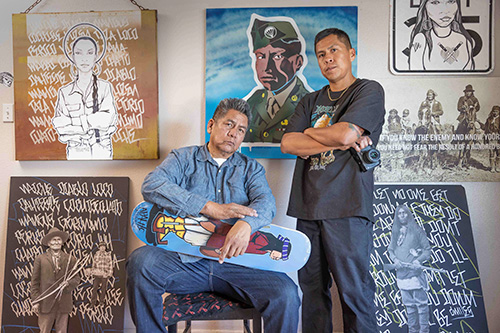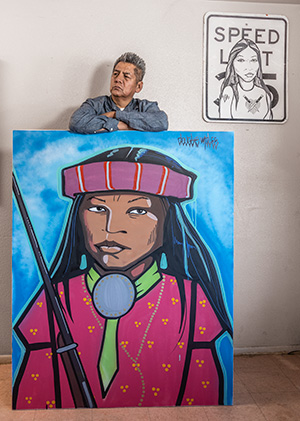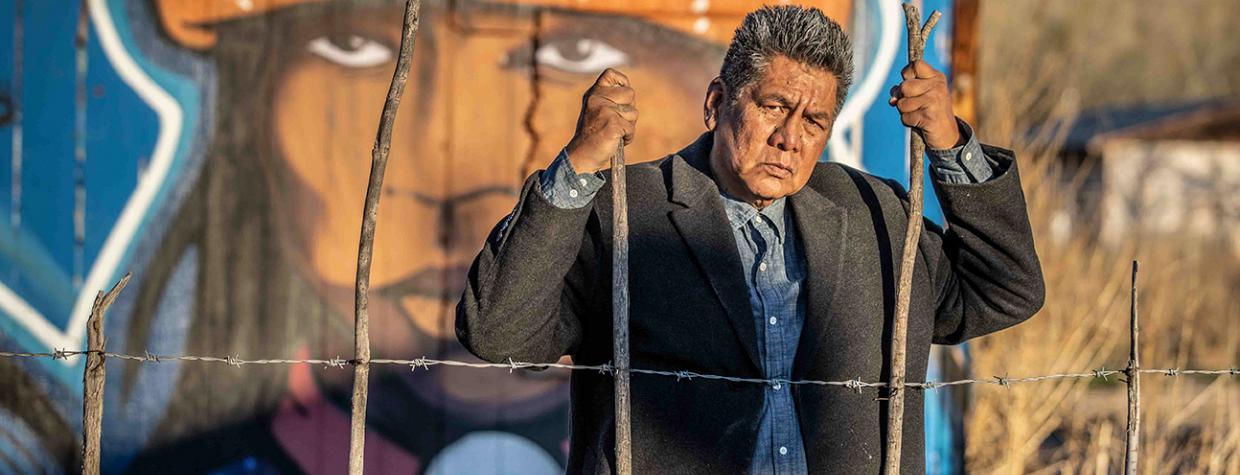Douglas Miles is busy. In the space of a few weeks, he’scrisscrossed the country to paint a mural in Cincinnati and flown to the University of Missouri for a screening of Apache Leap, which made its debut in the Portland Film Festival. Miles played a starring role in addition to co-producing the feature film.
Soon, he’ll be back home on the San Carlos Apache Tribe’s land, where Miles will be supporting his son, Douglas Jr., and his crew while they produce a short film. Then he’ll travel to Miami for a mural commission in the Wynwood district, which boasts work by some of the world’s best-known street artists. But today, accompanied by two young artists and a box of spray paints, he faces a large, blank canvas on Arizona State University’s Tempe campus.
Miles describes himself as an artist, photographer, curator, writer, muralist, public speaker and director. Museums around the country, including the National Museum of the American Indian and the Institute of American Indian Arts, have collected his work. His public art includes murals on San Carlos Apache land, along with works in San Francisco, the Bronx and New Orleans.
But Miles may be best known as the founder of Apache Skateboards, one of the country’s first Indigenous-owned skateboard companies. With a long history among American Indians, skateboarding is riding a wave of popularity boosted by its debut last year as an Olympic sport. Apache Skateboards’ umbrella includes a skate team led by Douglas Jr., apparel, photography and film.
In 2019, National Geographic selected the documentary The Mystery of Now, which Miles co-wrote and co-produced, for its short-film showcase. The 16-minute film features Miles, Douglas Jr. and skateboarders on San Carlos Apache land.

“I’m multidisciplinary and multifaceted,” Miles says. “Sometimes there’s a focus on our filmmaking. Sometimes I’ll focus on Apache Skateboards. Sometimes a mural project opens up. I started a skateboard company, but
I got into public art, got into film and photography. Just a lot of work that I create.”
And now, Miles is at ASU, as the first artist in residence for the School of Historical, Philosophical and Religious Studies. It’s a position the school’s director, Richard Amesbury, created to bring Miles to ASU, which claims to graduate more American Indian students than any other university in the United States. “Art has a powerful way of shaping the context of higher education,” Amesbury says. “It signals to the viewer something about what we value and who we value.”Miles will spend the next few days painting a mural for the school’s reception area.
Miles grew up in and around South Phoenix, where he began drawing Batman and other comic book characters as a child. As he got older, he became interested in street art influenced by graffiti artists and the lowrider culture of the 1970s. But he also had a strong sense of his Apache and Akimel O’odham heritage via frequent visits to family members on San Carlos Apache and Gila River lands.
Although he attended graphic design school hoping to earn a living making art, Miles instead got a job at Motorola. “I didn’t have confidence in my work,” he says. “My mom would tell me, ‘You need to sell your work, sell your artwork.’ [My family] kept encouraging me, took me to art shows and art markets. They kind of pushed me, in a good way.”
Those efforts paid off. In 1996, Miles’ Prismacolor, pen and ink drawing Apache Brothers earned a first-place award at the Santa Fe Indian Market. It’s now part of the Eddie Basha Collection. But Miles’ art career took an unexpected turn in 2001, when Douglas Jr. wanted a skateboard. Miles couldn’t afford a name brand, so he bought a blank deck and painted an Apache warrior on it. “A hundred years ago, I would have made my son a bow and arrow,” he explained in a YouTube video. “But now, I’m making him a skateboard.”
When Douglas Jr. came home from school and said all his friends wanted a deck like his, Miles got the idea for a brand that would represent Indigenous people with Indigenous art. “I call that Apache Skateboards’ creation story,” he says. By then, he was living in San Carlos and producing and selling fine art. But fine art is expensive. Miles saw skateboards as a way to make art more accessible — not only to collectors, but also to kids. Employing what he calls “the power of the past,” he designed decks incorporating historical images of Apache warriors to remind Indigenous kids of their tribal heroes.
“Tribal kids are already proud,” he says. And he believed Apache Skateboards would add to that pride. Social media, then still in its infancy, helped the company find a wider audience — and, in some ways, Miles’ life would never be the same. “I started Apache Skateboards, and then I started a skate team,” he recalls. “Then we started getting invited to do skate demos for different tribal communities. We were asked to go to different reservations, and we were working with youths.”
What people don’t know, he adds, is that while pursuing a career in fine arts, Miles was also working full time in San Carlos, doing social work with the tribe. He’d go into communities and see what they wanted to do, then help them build and fund those projects. “I was already working with young people,” he says. “And then I had my own family and my own kids. So, in some ways, it definitely changed my life. But in other ways, I was just doing what I was already doing, but I was doing it with Apache Skateboards now.”Photography and video became a way to document the skating and the community. “That’s important work,” Miles says. “Native American people have always had their stories told for them or dictated to us in numerous ways — in Western films, anthropology museums, books, pulp fiction. They all tell a story of Native American people, but from a non-Native perspective. We don’t want people to forget what we’re doing, but we also want people to know that what we are creating in and around San Carlos is art. We’re making art. We’re not just sitting under a palm tree, hoping tourists come by.”
At ASU, a livestream captures Miles, wearing a dark long-sleeved shirt, rolled-up jeans and sneakers, as he sketches out the mural’s composition with spray paint. Over the next several days, he adds details and layers in color with help from artists and skate team members Tray Polk and Brina Adley.
Miles works out the composition as he goes. Deciding on three faces instead of the four he originally planned, he paints a large geometric pattern in place of one figure. Students wearing T-shirts and backpacks, and faculty members in button-down shirts with messenger bags, move past. Miles pauses often to talk with those curious enough to stop. “This is just the sketch process,” he tells them. “By the time I’m done, it’s going to be very bright. And this whole room is going to smell really bad.”

Everyone laughs. Turning back to the canvas, Miles paints in facial details, then sprays over them and starts again, this time creating sharper, more angular features while leaving the eyes eerily blank. “That comes last,” he tells an onlooker.
Despite his early appreciation of graffiti — which he describes as a tribal art form — Miles didn’t start painting with aerosols until about eight years ago. He credits a friend, muralist Thomas “Breeze” Marcus (see Native Art, page 26), with encouraging him. “It was not an easy transition, and it’s still not for me,” he admits. “It’s not an easy thing to paint with.”
But then, public art itself is not easy. Usually, it involves painting outdoors, which means dealing with the elements. And it’s physically demanding. “You need to use ladders, scaffolds, climbing up and down, scissor lifts,” he says. “The larger the surface, the more days you’re out there. It’s time-intensive, and it’s labor-intensive.”
Leaving the faces, Miles works out colorful geometric patterns on each side of the figures. He fills in the outlines with red, then adds bands of purple and yellow. On one side, the pattern rises like a flame. On the other, jagged lines stretch out horizontally, like a comics balloon: Pow! Above the figures, Miles paints tiny clouds in a light-blue sky.
Polk and Adley begin to fill in the outlines of the figures’ hair with midnight blue while Miles returns to the faces, shading the features before returning to the hard, geometric shapes. He adds an outline of white, painting over some of the clouds, and adds another pattern across the top. He returns to the faces, still staring blankly, and adds details to the hair, painting a necklace of white dots onto one figure and patterning the headband of another. Finally, he animates the eyes, adding eyebrows and irises to bring the faces to life.
“I’ve had friends say, essentially, I am a portrait artist, because I’m always painting Native people,” Miles says. “I think that in itself is a powerful thing, because Native people don’t really exist in media, so it’s important to have these big Native faces out there.”
Polk and Adley paint white dots, like the leading edge of a veil, in each figure’s hair. Tiny constellations take shape in the tresses. The figure on the left gets a line of white dots along each side of her face. The finished mural is colorful and dynamic, with the trio at the center gazing out serenely. Miles adds his signature, in graffiti style, at the bottom.
“By placing this art here,” Miles says, “this street art with graffiti roots, which is really the art of the people, which is really a new monument, which is really a placemaker for ourselves, for Indigenous kids or Chicano, Black and Asian kids ... when they come in here, they will immediately feel at home.
“The painting really is about having a Native American presence here at ASU,” he continues. “But it’s also a tribute to my own heritage. I’m Apache, from San Carlos, but I’m also O’odham. ASU is actually on the traditional homelands of the O’odham people. So, I found it only fitting that the first character is O’odham.”
Perhaps that’s also why he chose a certain skateboard deck to be raffled off as part of the project. It’s a popular deck with a simple message: “You’re skating on Native land.”
To learn more about Douglas Miles, visit douglasmiles.co. To learn more about Apache Skateboards, visit apacheskateboards.com.

